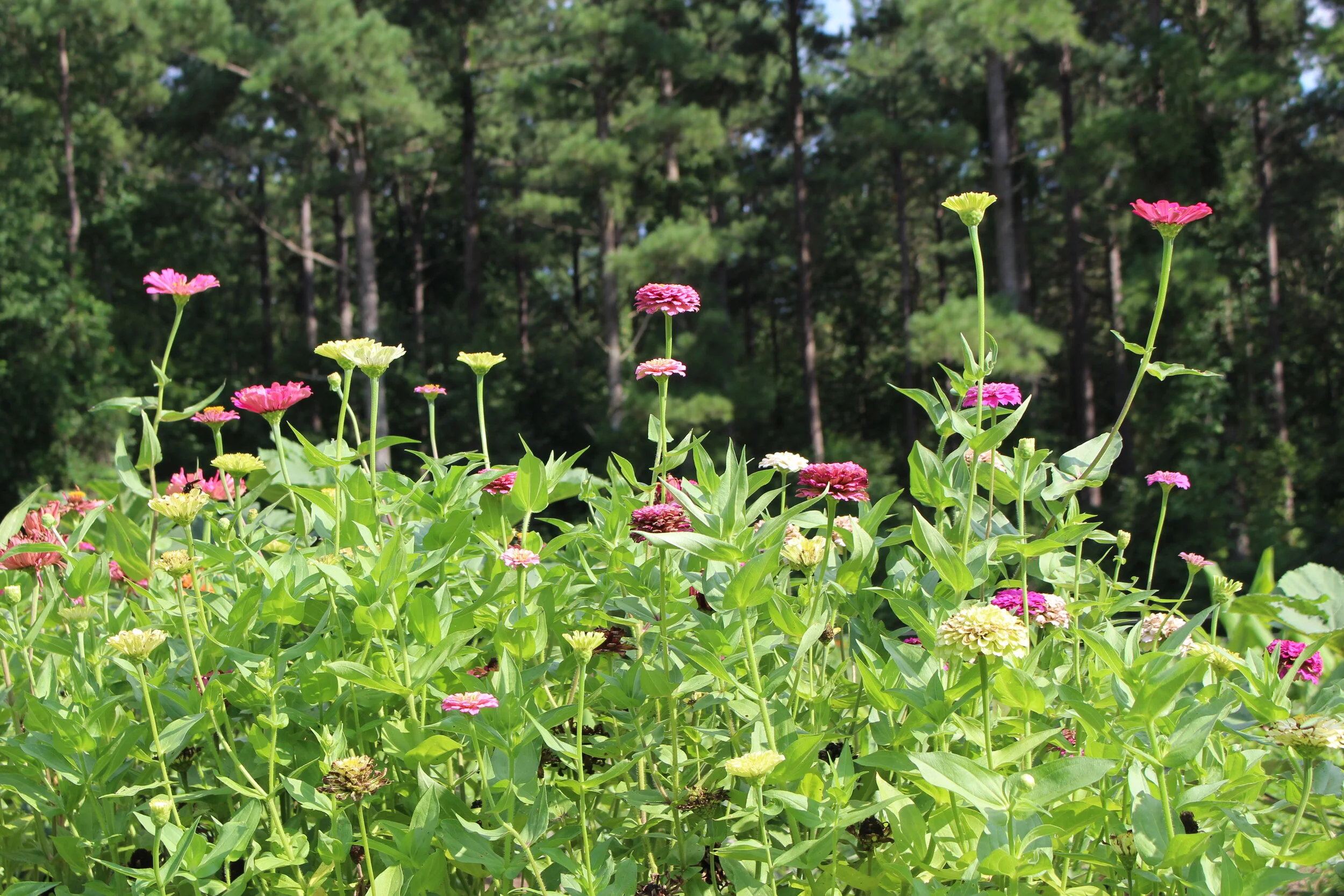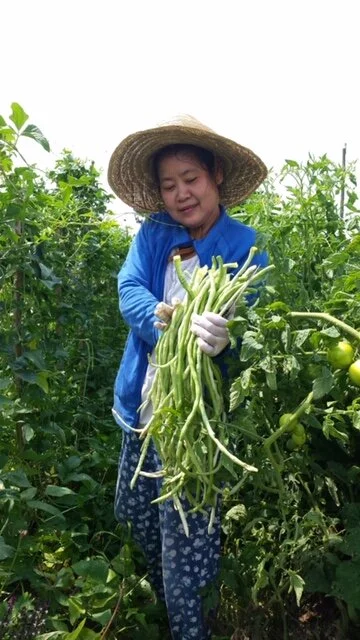
What We Grow
Vegetables
-
This variety is the standard gourd seen and sold in most Asian markets.
Fruits are light green, with white flesh, 16-24 inches long and 3-4 inches across.
Young fruits are sweet and delicious, good for stir-fry and soup.
This variety is very popular in Asian dishes.
Commonly used in stir-fries, steamed, soups, curries and fried.
-
Pea eggplants look like green peas clustered together like grapes with short stems. The pea eggplants are not widely available in the US. The bush is quite large, taller than a man.
The two primary ways they are eaten are fresh, in chili sauce and cooked in curry. They are typically cooked whole and have an authentic taste, a slightly bitter flavor and a unique texture that bursts satisfyingly in the mouth when eaten. Pea eggplant can be stir-fried, pickled and used in curries or soups.
-
Thai peppers are spicy chili peppers with a wide range of heat, and despite common belief, there is no single type of Thai pepper, there are at least 79 separate varieties.
The peppers grown at the Karen Community Farm at Oaky Grove are HOT! Thai chilies are among the hottest peppers available, and can sometimes be rated at 100,000 Scoville heat units.
They are commonly used in the cuisines of Thailand, south India, Vietnam and elsewhere in southeast Asia.
The chilies themselves are relatively small, and grow plentifully on the small plant. They typically take on a deep red color as they reach maturity.
-
Bitter Melon is a tropical and subtropical vine of the family Cucurbitaceae, widely grown in Asia, Africa, and the Caribbean for its edible fruit, which is among the most bitter of all fruits. This fruit is pretty nutrient-dense and most notably high in vitamin A, vitamin C, and folate.
Bitter gourd is generally consumed cooked in the green or early yellowing stage. This strange-looking gourd that people harvest for its edible fruit looks like a fusion between a bumpy green gourd and a zucchini. The young shoots and leaves of the bitter gourd may also be eaten as greens. It is often used in Thai and Chinese cooking for its bitter flavor, typically in curries, stir-fries, soups, and also as tea. In Thailand it is often stuffed with spiced minced pork and is served in soups. It is very popular throughout South Asia. In North India, it is often prepared with potatoes and served with yogurt on the side to offset the bitterness.
Bitter melon is a unique and It’s a staple veggie around Asia – especially India.
-
Snake gourd, also known as snake squash or serpent gourd, is a type of gourd grown for its elongated, edible fruit.
Besides being a tasty and healthy treat, it has a unique appearance in the garden, with what looks like several snakes hanging from its vines and wispy white flowers.
Snake gourd is native to the tropical and subtropical regions of South and Southeast Asia, but it also grows in Australia, western Africa, and Latin America. It is used in cooking, where its mild, cucumber-like flavor pairs well with dishes such as soups, curries, and even stir-fry.
-
Yard long beans are a nutritious and delicious addition to any diet. They offer a variety of health benefits, including helping to regulate blood sugar levels, improving digestion, and reducing inflammation.
Yard long beans, also known as asparagus beans, snake beans, or bora, are a type of legume that is popular in Asian cuisine. They are similar in appearance to green beans but can grow up to three feet long.
Yard long beans are a good source of protein, fiber, and vitamins A and C. They also contain minerals such as iron, potassium, and magnesium.
They can be eaten raw or cooked and are often used in stir-fries, curries, and other Asian dishes. This vining bean grows similar to pole beans except the beans grow from 18 to 36 inches.
-
Okra is a fruit, though it is eaten as a vegetable. The light green seed pods are cooked whole or sliced, so preparation is extremely easy, and it can be cooked in so many ways. However, choosing the right cooking method, such as frying, grilling, sautéeing, and pan-roasting, can reduce or prevent it from becoming slimy.
Okra has a mild, almost grassy flavor that is uniquely okra. While it's sometimes compared to the taste of eggplant or green beans, its texture gets more attention. Okra is crunchy when cooked quickly but becomes almost mouthwateringly tender when slow-cooked.
-
Daikon radish is a winter root vegetable and a mild-tasting radish. It’s less spicy than the red radish you might know. It’s also much larger, tending to be a longer veggie. If you see them at the store, you might be impressed by their size! It’s almost like a white carrot. Daikon is most well-known because it’s a prominent ingredient in traditional kimchi from Korea.
It can be had both raw and cooked. It makes for a nice crunchy garnish or even a snack for dipping into hummus or guacamole. You can also top off your favorite soups and salads with it for a flavorful crunch. Lastly, it’s a good source of vitamin C.
What Does It Taste Like? Raw daikon radish has a sweet and lightly spicy flavor, and it tends to be milder than a peppery red radish. The level of spice can depend on the variety of white radish, with some having a stronger flavor. The flesh is very crunchy and juicy.
-
Unlike the eggplant you may be familiar with, Thai eggplants are small, golf ball-sized, and round. They’re also often green. However, there are a few varieties and they may also be white, yellow, or purple. They are often found cooked in Thai curries or raw in Thai salads. The taste is quite bitter, but they absorb the flavor of the sauce they’re cooked in. Outside of Thailand, they can be hard to find and aren’t commonly used.
-
Asian green that you can stir fry with garlic and seasoning sauce.
-
Vine that you harvest the first foot of the young shoots.
This vegetable is very high in iron and is very good for women to eat.
You can eat it raw or fry with an egg and is very popular in Karen culture.
-
Low growing Asian green that is eaten raw in salad.
Karen farmers make salad and add tomato, crushed peanuts, crispy onion, and add mushroom seasoning to add flavor.
Herbs & Spices
-
Turmeric, a plant in the ginger family, is native to Southeast Asia and is grown commercially in that region, primarily in India. Its rhizome (underground stem) is used as a culinary spice and traditional medicine.
Turmeric is well-known these days due to its anti-inflammatory properties. It’s a superfood ingredient when it comes to healthy food bloggers and wellness pros. It’s also been used in Asian cuisine and traditional medicine for a long time. The main active ingredient in turmeric – curcumin – is the showstopper when it comes to the health benefits of this vibrant yellow spice.
Combining turmeric with black pepper will help to make the curcumin more bioavailable and easily absorbed in the body. Turmeric gives many Asian dishes the color that makes them so distinct such as rice dishes like pilaf or curries.
Turmeric is a common spice and a major ingredient in curry powder. Curcumin is a major component of turmeric, and the activities of turmeric are commonly attributed to curcuminoids (curcumin and closely related substances). Curcumin gives turmeric its yellow color.
-
Kaffir lime leaves are thick, dark green and shiny on the top, porous and pale on the back. A leaf has two connecting leaves, ‘double leaves’. Tear a leaf to smell the distinct aroma. Fresh kaffir lime leaves keep well in a refrigerator for at least 2 weeks. If the recipe calls for kaffir lime leaves and you can’t find any, skip the leaves. Don't substitute. The fragrance is so distinct that it is irreplaceable.
Kaffir lime leaves are too tough to just eat, so they're either kept large and reserved, or sliced thin. Many Thai recipes call for the kaffir lime leaves. If the leaf is used whole, like in curry or in soup, most people do not eat the leaf itself. To prepare, tear the leaf by holding on to the joint between the two leaves and tear the leaf away. When you eat, you just avoid eating the leaf and move it to the side of your plate or bowl.
-
Cilantro… you love it or you hate it, and either way is okay. Some folks will taste soap when they have it, but many just get those bright citrusy notes instead. It has a really fresh flavor that suits so many meals, especially those with a little spice. It is the perfect accompaniment to countless dishes and a handful to garnish your favorite meals is a must-have if you enjoy it. If you cook a lot of Asian meals you likely always have some handy. Plus, this one is super easy to grow in a container. Also, it’s rich in vitamin K. Both fresh cilantro and dried cilantro (often called coriander) can readily be found in most stores
-
Lemongrass is a citrusy stalk that is crushed to release a beautiful, fresh, and zesty flavor to many Asian dishes. The taste might be best compared to ginger. It is mostly found in Thai food but also common in Indian, Sri Lankan, and Indonesian food. Lemongrass can be used both fresh and dried, though dried lemongrass takes a while to rehydrate which is something to consider when using it.
Typically, the stalks are crushed or punctured prior to using them in a dish. This allows the lemongrass to release flavor during cooking. When the final meal is served, the stalks should be removed. This is a really easy way to elevate your cuisine with an authentic taste!
-
Harvest the leaves and use in soups. You stir fry the young leaves with bamboo shoots, onions, garlic, lemongrass, fresh chili and sardines to eat with rice.
Flowers
-
Daffodils
Anemones
Ranunculus
Irises
Tulips
-
Snapdragons
Dianthus
Poppies
Sweet Peas
Gladiolus
Lisianthus
-
Sunflower
Zinnia
Cosmos
Dahlias
Tuberosa
Celosia




